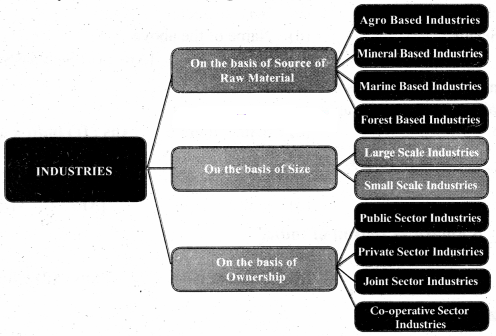8th Social Science – Geography Book Back
& Questions Answers (solution)
Term 3
1. Industries
8th Social Science Geography Solutions Term 3 – Chapter 1 Industries Tamilnadu Samacheer Kalvi – English Medium
I. Choose the correct answer:
1. Silk weaving and house hold industries come under the category of ……………
(a) Small scale industry
(b) Large scale industry
(c) Marine based industry
(d) Capital intensive industry
Answer: (a) Small scale industry
2. On the basis of ownership the industry can be divided into ………….. types.
(a) 2
(b) 3
(c) 4
(d) 5
Answer: (c)4
3. Amul dairy industry is best example of ………….. sector.
(a) Private Sector
(b) Public Sector
(c) Co-operative Sector
(d) Joint Sector
Answer: (c) Co-operative sector
4. Iron and Steel and Cement Industries are the examples of ………….. industries.
(a) Agro based
(b) Mineral based
(c) Forest based
(d) Marine based
Answer: (b) Mineral based
5. Tertiary activity is divided into ………….. types
(a) 4
(b) 3
(c) 2
(d) 5
Answer: (c) 2
II. Fill in the Blanks:
- Banking is a ………….. economic activity.
- Tertiary activity is divided into ………….. and …………..
- Government decision making process comes under the ………….. category of tertiary economic activity.
- Raw material based perspective Cotton Textile industry is a ………….. industry.
- Capital required for establishing a large scale industry is,more than ……………
Answer:
- Tertiary
- Quaternary/Quinary
- Quinary
- Agro based
- one crore
III. Match the following:
- Judicial sector – Private Sector
- TV telecasts – Non Geographical factor
- Geographical factor – Quaternary activity
- Capital – Raw materials
- Bajaj Auto – Quinary activity
Answer:
- Judicial sector — Quinary activity
- TV telecasts – Quaternary activity
- Geographical factor – Raw materials
- Capital – Non Geographical factor
- Bajaj Auto – Private Sector
IV. Distinguish the following:
- Secondary economic activity and tertiary economic activity.
Answer:
1. Secondary economic activity:
- Secondary activities are those that change raw materials into usable products through processing and manufacturing.
- Bakeries that make flour into bread and factories that change metals and plastics into vehicles are examples of secondary activities.
2. Tertiary economic activity:
- Tertiary economic activities are those that provide essential services and support the industries to function. Often it is called service industries.
- It includes the transportation, finance, utilities, education, housing, medical and other services.
2. Agro based and marine based industries.
Answer:
1. Agro based industries:
- These industries use plant and animal based products as their raw materials.
- Example; Food Processing, Vegetable Oil, Cotton Textile, Dairy Products, etc.
2. Marine based Industries:
- These industries use products from the sea and oceans as raw materials.
- Example; Processed Sea Food, Fish Oil manufacturing units etc.
3. Large scale industries and small scale industries.
Answer:
1. Large scale industries:
- The capital required for the establishment of an industry is more than one crore the industry is called as large scale industry.
- Iron and steel, Oil refineries, Cement and Textile industries are the best examples for large scale industries.
2. Small scale Industries:
- The capital required for the establishment of an industry is less than one crore, the industry is called as small scale industry.
- Silk weaving and household industries belong to this category.
V. Answer briefly:
- Define industry.
Answer:
Industry is a process by which the raw materials are changed into finished products.
2. What is meant by economic activity?
Answer:
Any action that involves in the production, distribution, consumption or services is an economic activity.
3. Name the major economic activities.
Answer:
The major economic activities are:
- Primary Economic Activities (e.g., Raw cotton production)
- Secondary Economic Activities (e.g., Spinning mill)
- Tertiary Economic Activities (e.g., Trade,Transport)
4. What are the secondary economic activities? Give some examples.
Answer:
- Secondary activities are those that change raw materials into usable products through processing and manufacturing.
- Bakeries that make flour into bread and factories that change metals and plastics into vehicles are examples of secondary activities.
5. What is Quinary activity? Elucidate with an example.
Answer:
- Quinary economic activities refer to the high level decision making processes by executives in industries,business, education, and government.
- This sector include top executives or officials in the fields of science and technology, universities health care etc.
- In our house, our parents make decisions by themselves in some situations. Similarly, the Council of Ministers take decisions to introduce various people welfare schemes in the state.
- These two are examples of quinary activities.
6. Name the factors responsible for the location of industries.
Answer:
The locational factors of industries are grouped into.
- Geographical factors and
- Non-Geographical factors
1. Geographical factors include:
- Raw Materials
- Power
- Labour
- Transport
- Storage and Warehousing
- Topography
- Climate and
- Water resources.
2. Non-Geographical factors include:
- Capital
- Availability of loans and
- Government Policies / Regulations.
7. Write a short note on the following
Answer:
- Large scale Industries
- Small scale industries
1. Large scale Industries:
The capital required for the establishment of an industry is more than one crore the industry is called as large scale industry.
Eg : Iron & steel, Oil refineries, Cement and Textile industries etc.
2. Small scale industries:
The capital required for the establishment of an industry is less than one crore, the industry is called small scale industry.
Eg : Silk weaving and household industries.
VI. Write in detail:
1. Classify and explain the industries based on the source of raw materials.
Answer:
Industries are classified on various bases in the following ways. On the basis of raw materials.
1. Agro Based Industries:
- These industries use plant and animal based products as their raw materials.
- Example; Food Processing, Vegetable Oil, Cotton Textile, Dairy Products, etc.
2. Mineral Based Industries:
- These are the industries that use mineral ores as their raw materials.
- Iron made from iron ore is the product of mineral based industry. Cement,Machine Tools, etc. are the other examples of mineral based industries.
3. Marine Based Industries:
- These industries use products from the sea and oceans as raw materials.
- Example; Processed Sea Food, Fish Oil manufacturing units etc.
4. Forest Based Industries:
- These industries use forest products as their raw materials.
- Example; Pulp and Paper, Furniture and Some Pharmaceuticals industries, etc.
2. Explain the Geographical factors which affect the location of industries?
Answer:
Geographical factors which affect the location of industries are:
1. Raw materials:
Industries like iron and steel and sugar industries are located near the place of availability of iron ore and sugar cane respectively.
2. Power:
Power is base and essential to run the entire industry. Power is mostly generated from the conventional sources like coal, mineral oil, and water.
3. Labour:
Availability of cheap and skilled labour is another important requirement.
4. Transport:
It is needed for transporting raw materials to the industries and also for sending the finished products to the market. Availability of easy transportation always influences the location of an industry.
5. Storage and Warehousing:
Finished products should be stored at suitable storage or warehouse.
6. Topography:
The site that is selected for the establishment of an industry must be flat.
7. Climate:
Extreme climate condition is not suitable for the successful industrial growth. Cool- humid climate is ideal for cotton textile industry. Hence Coimbatore and Tiruppur are important for Cotton Textile Industries.
8. Water Resources:
Availability of water is another important factor that influences the industrial location.
3. Classify the industries through a flow chart.
Answer:

VII. Hot:
1. Find out the reasons for uneven distribution of industries in India.
Answer:
- The distribution of Industries in India is highly uneven.
- This is so partly on account of uneven distribution of the necessary raw materials and power resources.
- And partly due to the contributes of enterprises, financial resources and other necessary condition in large towns.
- Where there is good transport system, the industries flourish.
- India’s regional growth performance has been particularly uneven.
- Jharkhand, Orissa, Chhattisgarh, Parts of Rajasthan, Karnataka and Tamil Nadu account for most of the reserves of metallic minerals. These are located particularly in north eastern part of Peninsula.
- Agro based industries including Cotton, Jute and Sugar are heavily concentrated in the raw material producing areas.
- The coastal belt of Kerala has a heavy concentration of coir, copra and fish carrying industries.
Tags:
8th social guide samacheer kalvi,samacheer kalvi 8th books guide social science,social guide for 8th standard samacheer kalvi,samacheer kalvi guru 8th social guide,8th standard social guide samacheer kalvi,samacheer kalvi 8th social guide pdf,8th social guide tamil medium samacheer kalvi,8th social guide tamil medium samacheer kalvi,samacheer kalvi 8th books guide social science,samacheer kalvi guru 8th social guide,samacheer kalvi 8th social guide pdf,8th standard social guide samacheer kalvi,8th social guide tamil medium samacheer kalvi,8th social guide tamil medium samacheer kalvi,social guide for 8th standard samacheer kalvi,samacheer kalvi 8th books guide social science,samacheer kalvi guru 8th social guide,social guide for 8th standard samacheer kalvi,samacheer kalvi 8th social guide pdf,8th standard social guide samacheer kalvi,samacheer kalvi 8th books guide social science,samacheer kalvi guru 8th social guide,social guide for 8th standard samacheer kalvi,8th social guide tamil medium samacheer kalvi,8th standard social guide samacheer kalvi,8th social guide tamil medium samacheer kalvi,samacheer kalvi 8th social guide pdf,samacheer kalvi 8th books guide social science,social guide for 8th standard samacheer kalvi,samacheer kalvi guru 8th social guide,8th social guide tamil medium samacheer kalvi,8th standard social guide samacheer kalvi,samacheer kalvi 8th social guide pdf,8th social guide tamil medium samacheer kalvi,samacheer kalvi 8th books guide social science,social guide for 8th standard samacheer kalvi,samacheer kalvi guru 8th social guide,8th social guide tamil medium samacheer kalvi,8th social guide tamil medium samacheer kalvi,samacheer kalvi 8th social guide pdf,8th standard social guide samacheer kalvi,samacheer kalvi 8th books guide social science,samacheer kalvi guru 8th social guide,social guide for 8th standard samacheer kalvi,samacheer kalvi 8th social guide pdf,8th standard social guide samacheer kalvi,8th social guide tamil medium samacheer kalvi,samacheer kalvi 8th books guide social science,social guide for 8th standard samacheer kalvi,samacheer kalvi guru 8th social guide,8th social guide tamil medium samacheer kalvi,8th standard social guide samacheer kalvi,samacheer kalvi 8th social guide pdf,8th social guide tamil medium samacheer kalvi,


